한식 읽기 좋은 날
The Present and Future of Korean Desserts
HANSIK Dialogue
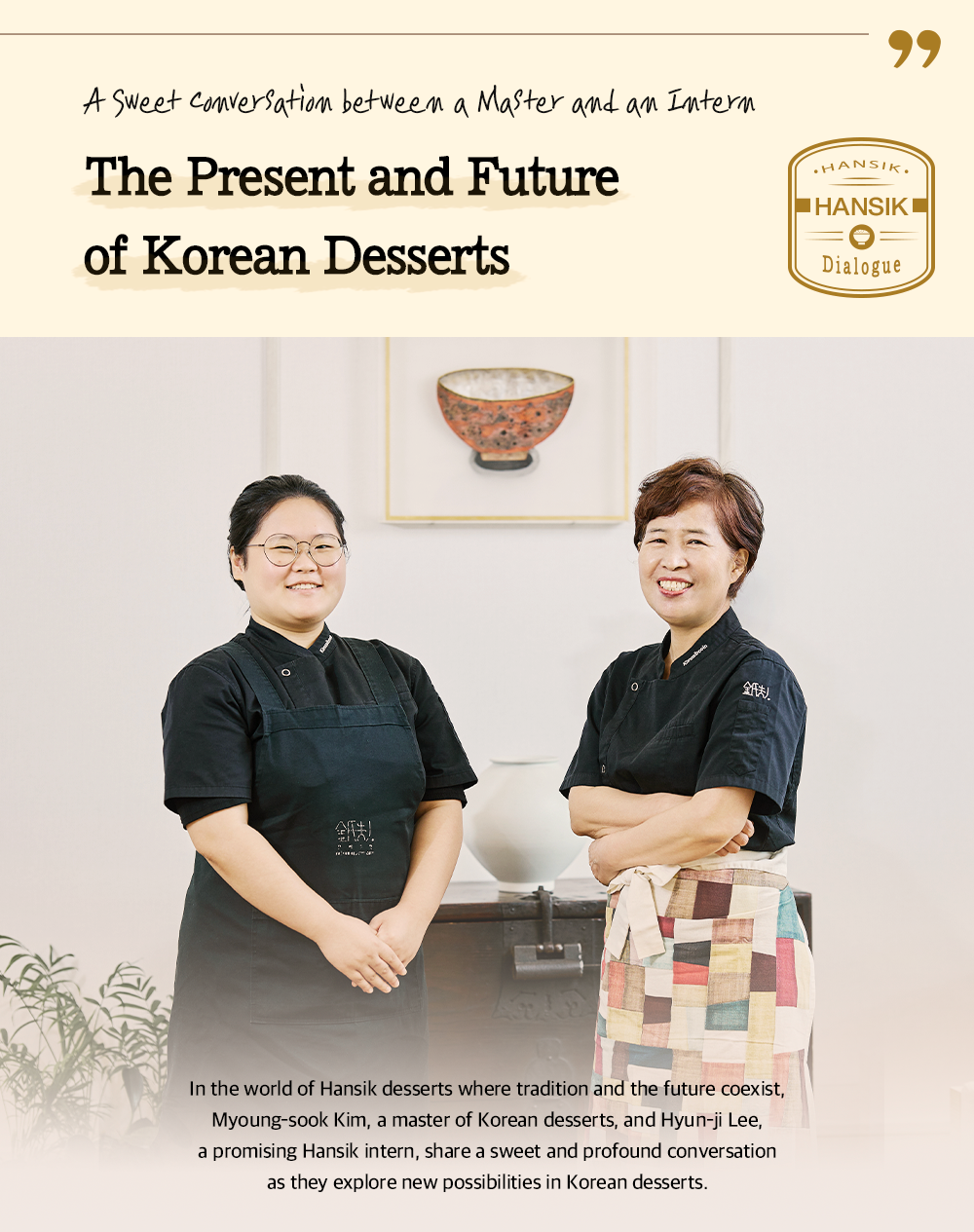
Korean desserts, increasingly known as ‘K-Desserts’, are poised for a vibrant future thanks to innovative individuals. Meet Myoung-sook Kim, founder of Kimssibooin, who is introducing the charm of Korean sweets to younger generations. Also, meet intern Hyun-ji Lee, who aspires to become a leading expert in Korean confectionery by mastering various traditional techniques.

Myoung-sook Kim, the head of the Korean dessert café Kimssibooin, presents traditional desserts that delight both the eyes and the palate. She draws on techniques passed down from Master Sun-ja Choi and Master Myeong-hwan Seo, who have researched traditional rice cakes and Korean sweets. Intern Hyun-ji Lee, who has been passionate about Korean confectionery since childhood, pursued study at a specialized high school and then majored in Korean Culinary Arts to realize her dream of becoming a Korean food expert. Currently participating in the ‘2024 Korean Restaurant Young Chef Discovery Internship Program’ organized by the Ministry of Agriculture, Food and Rural Affairs and the Korean Food Promotion Institute, Lee is learning a wealth of knowledge and techniques from Kim to grow as a future Hansik specialist.

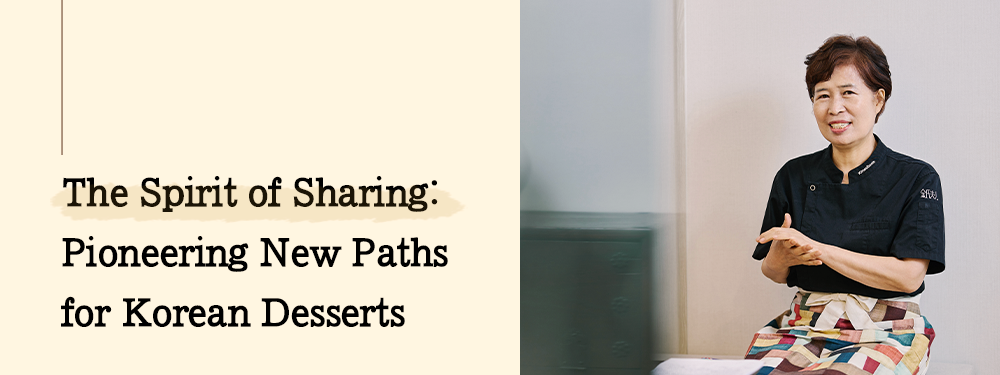
Q. What inspired you to start making traditional Korean desserts like tteok (rice cake) and hangwa (traditional Korean confectionery)?
Kim: My journey began with a desire to make tteok and hangwa for my family, who loved these traditional sweets. I was particularly moved by the taste of *Gaeseong juak and felt a deep sense of duty to share such wonderful Korean desserts with more people. I opened the Korean dessert café with the intention of sharing the beauty of traditional desserts with a wider audience. At that time, there weren't many such cafes, so I often heard that I was pioneering a new path. I believe that future generations will continue to blaze even more exciting and innovative trails. Guiding young talents and spreading our unique dessert culture brings me immense satisfaction.
Lee: I've had a keen interest in hangwa since I was young. During high school, I honed my knowledge and cooking skills through club activities, nurturing a dream of 'globalizing traditional Korean confectionery.' With Hansik gaining global attention, I became even more convinced of its potential. I applied for the Young Chef Discovery Internship Program to learn cooking methods and philosophies from professionals in the field. This led me to meet CEO Kim. Every day, I learn a great deal about Korean desserts from her, and I'm grateful that she treats me not just as an intern but like a real junior staff member, allowing me to learn and grow extensively.
* Gaeseong juak: A traditional food of Gaeseong (southern part of North Korea). Resembling small pebbles, it is made by kneading glutinous rice with makgeolli (unrefined rice wine) and deep frying it. It is then coated with syrup. The sweet syrup and fragrant ginger blend together, creating a delightful burst of sweetness.
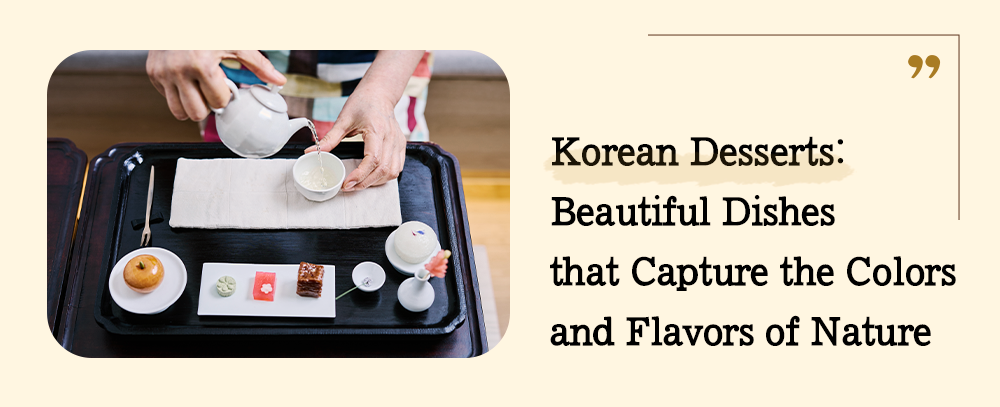
Q. What do you think is the unique charm of Korean desserts?
Kim: The charm of Korean desserts lies in their connection to the seasons and traditional holidays. The distinct four seasons and seasonal celebrations in Korea are reflected in the ingredients and colors of our desserts. In spring, you have sprouts and sunlight; in summer, namul (seasonal vegetables) and fruits; in autumn, ripening fruits; and in winter, root vegetables are incorporated into desserts. Using ingredients that align with the seasons naturally creates desserts that are both healthy and visually appealing. Particularly when the obangsaek (five colors) are harmoniously combined on a plate, it brings comfort to our bodies and delight to our eyes. Therefore, we strive to utilize the colors of nature and incorporate all five colors in our presentations.
Lee: I believe Korean desserts are the most refined type of dessert. When I first encountered ‘maejakgwa’ (fried twist), I was captivated by how even simple ingredients could be beautiful. This encounter led me to study traditional desserts further, and I felt saddened by the perception of many that these desserts are only ‘old-fashioned treats’ reserved for holidays. Although they are gaining more attention now, I hope more people will come to appreciate the elegant charm of Korean desserts.
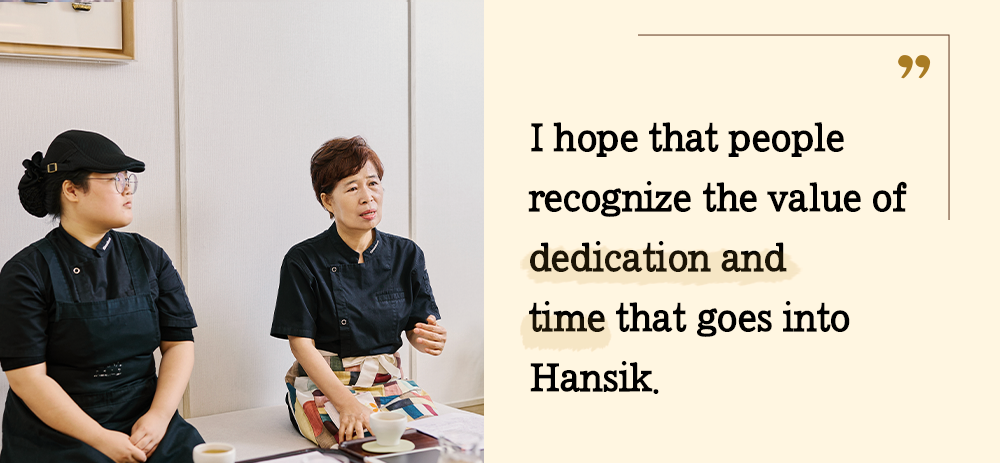
Q. What challenges have you faced while working in or learning about Hansik?
Kim: A common challenge is the lack of recognition for the value of traditional Korean food. While people are willing to pay high prices for foreign cuisine, handmade traditional foods, which require significant time and effort, often do not receive fair compensation.
Lee: Learning Hansik has shown me how deeply it embodies dedication and time. Among various foods I have studied, Hansik has been the most challenging. In particular, Korean desserts can be as delicate as art pieces, with outcomes varying based on temperature, ingredient quality, and hygiene. Achieving consistency with the same recipe can be very difficult. I hope that people will come to recognize and appreciate this effort and value.
Q. What qualities are most important for pursuing a career in Hansik?
Kim: To become a Hansik professional, a genuine love for Korean food is essential. If you see it merely as a job, it will be difficult to sustain in the long run. A deep affection for Hansik helps you maintain perseverance during challenging times. Physical stamina and patience are also crucial due to the lengthy processes involved. Additionally, since the visual aspect of food is important, having an aesthetic sense is necessary. I often advise my staff to visit art galleries or museums to cultivate their sensibilities.
Lee: I also believe that perseverance is crucial as I continue to learn Hansik. The labor-intensive and time-consuming nature of Korean cooking can be exhausting. I remember being surprised at how long it took to make certain desserts, realizing just how much effort is involved.
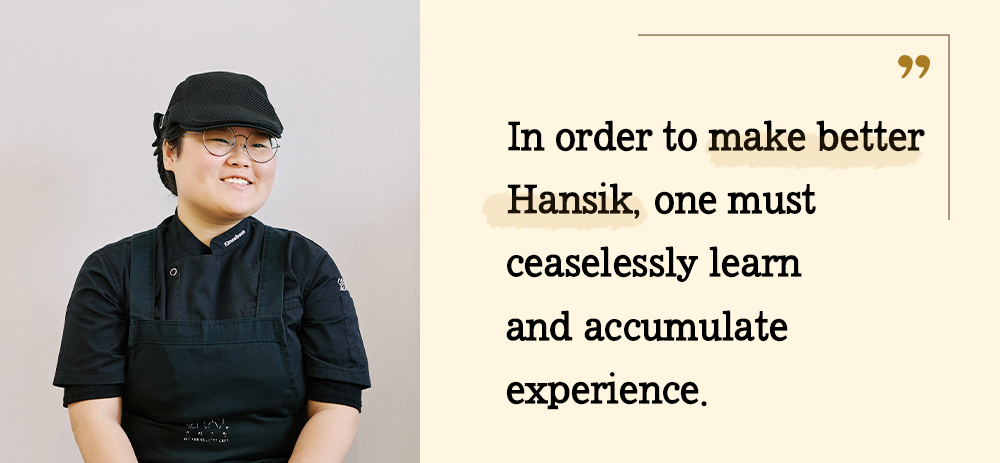
Q. What advice would you give to future generations entering the Hansik field, from your perspective as someone just starting out and from the perspective of an expert with over a decade of experience?
Lee: I would advise gaining as much experience as possible. Instead of just memorizing recipes, it’s crucial to try food at various restaurants and observe how it's made and the environment in which it's enjoyed. Reading books about Hansik to learn its history and culture is also important. Such experiences deepen your understanding of the field. CEO Kim also often emphasized the importance of tasting. Developing your palate by trying different foods is truly vital.
Kim: Along with the importance of experience, I would add the need for patience. Many people want quick results, but that often leads to a decrease in focus. Cooking is not something that can be rushed. Ceaseless effort and accumulation of experience are what leads to mastery. As the saying goes, “Success doesn’t come overnight”. So, even if it takes time, sincere and persistent effort will eventually lead to the desired results.
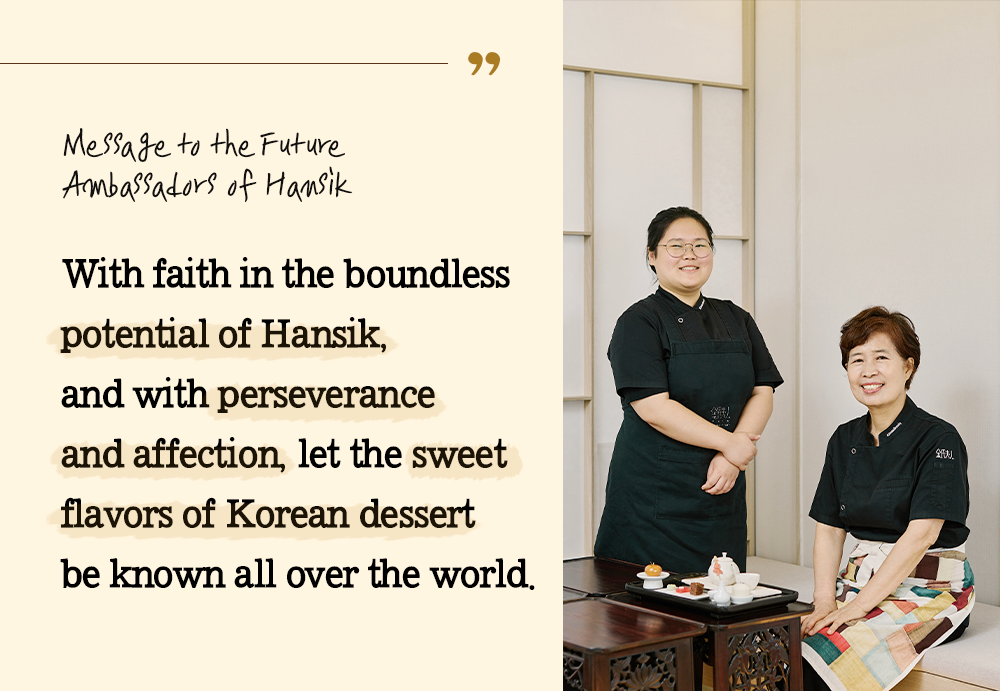
Q. K-Desserts are gaining worldwide popularity these days. What are your thoughts on the future prospects and potential of the Korean dessert market?
Kim: I am confident that the Korean dessert market will continue to develop significantly. When we held pop-up events in Daikanyama, Japan, and Paris a few years ago, the response was much hotter than expected. Especially in Paris, known for its strong dessert culture, over 3,000 visitors came, more than three times the anticipated number. This experience confirmed my belief in the potential of K-Desserts. As the number of Korean restaurants in Paris rapidly increases, I believe the Korean dessert market will also see substantial growth in the future.
Lee: I think that as people learn more about the meanings and histories embedded in traditional Korean confectionery, their appreciation for them will grow. Gradually introducing the charms of Korean desserts will lead to market growth over time.
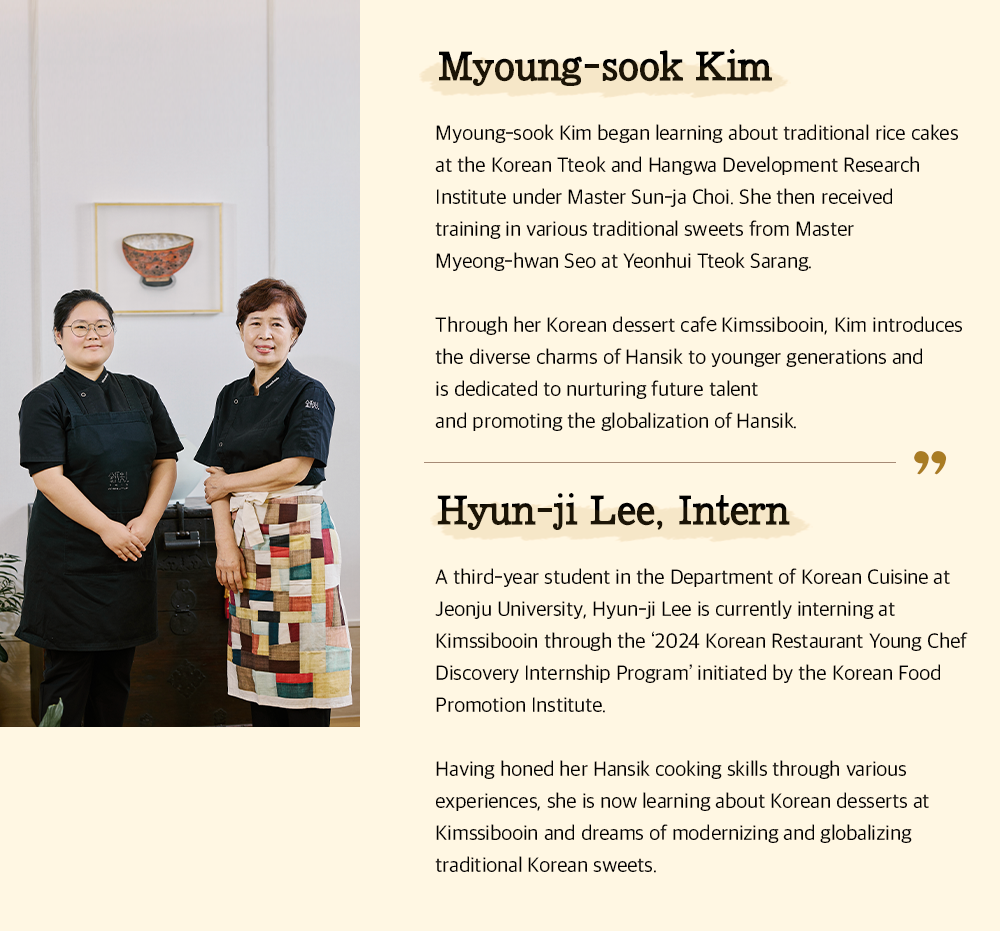

 한국어
한국어
 English
English






